Gel Battery Slag12100dt Optima Blue Top Battery Opt8016103
What's the Difference Between Optima Battery Colors ?
Use this for a vibration resistant, bulletproof, non-leaky starting-only battery.
Use this for starting and deep discharging - like winching, huge stereos, and 12V fridges.
Considered a marine and RV battery. Starting or starting/deep discharge versions are available.
This is the number one question people have. The short version is this:
RedTop Optimas: Starting battery - Your electrical system has a working alternator, a normal radio, no winch, no enormous lights, no big electrical loads.
YellowTop Optimas: Deep cycle battery - Your electrical system may or may not have an alternator, and has large electrical loads that suck down the battery, such as a winch or large aftermarket radio system.
BlueTop Optimas: Starting (dark case) or Deep Cycle (light case) batteries for marine/RV use - You need stainless steel battery posts with one of the above options.
That should give you a general idea of the type of battery that you need, but next we're going to take an in-depth look at each of these.
Keep reading, because Optimas have more differences than just the colors of their tops!
How Your Electrical System Works - READ THIS!
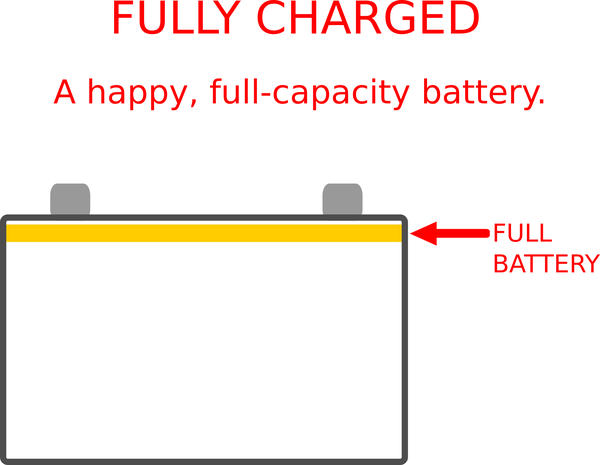
Most batteries like to live in this state for longevity. But we need them to do things that take them out of this state.
In a normal, stock vehicle the battery is just an electricity reservoir. It basically has one purpose: provide enough juice to start your vehicle.
That's it.
If you can understand that, you can easily pick the right Optima.
Along with the battery, there are two other major components to your electrical system:
- Things that make electricity: alternators/stators/generators
- Things that use electricity: winches, stereos, inverters, etc.
It's important to remember that batteries don't make electricity, they store it.
So let's get into that a little further and look at two battery types:
- Starting
- Deep Cycle
What is a Starting Battery?
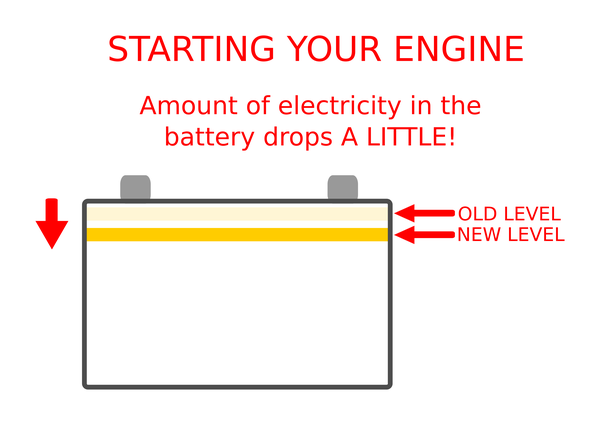
After a short, quick burst of electricity, your battery gets charged up. During starting, the amount of electricity in the battery doesn't drop very much.
Here's what the starting battery is best at:
A commute to work.
In normal operation, you start the car up in the morning, drive to work, and turn it off at work. Here's what happens:
- You start your car: Your starter motor draws a rapid burst of electricity from your battery for a few seconds while your engine turns over.
- You drive to work: Your alternator quickly tops off your battery as you drive.
- You turn off your car: You arrive at work and your battery is in the same state as when you left your house in the morning.
The battery's reason for existence is to start your car. On the drive, your alternator (not your battery!) powers your radio, lights, phone charger, ECU, and any other normal (OEM) electrical draw.
Your battery is a starting battery.
Starting batteries are:
- Used for starting a vehicle only
- Are almost always fully charged, except when drawn down slightly for starting
What is a Deep Cycle Battery?
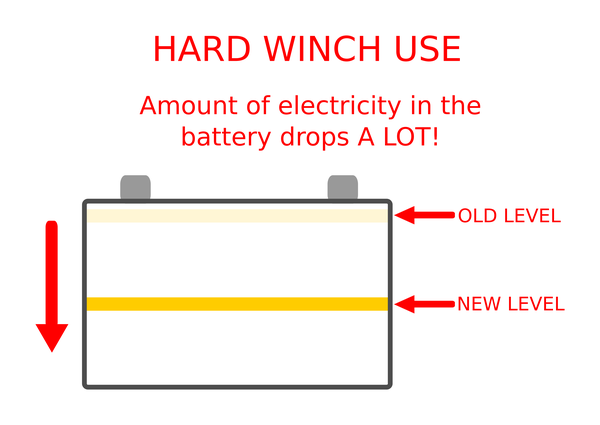
After a sustained winch pull or some other long-term, high draw electrical load, an enormous amount of electricity is taken out of the battery.
Let's take look at another scenario:
Winching.
You get stuck in a mud pit. You pull out some cable, hook up, and start reeling it in. In a real sticky mess, you could be pulling close to 500 amps off your battery as your winch reels in.
So here's the deal:
The difference between this and the commuter situation is that a winch pull can be long and intense! Your starter operates for a few seconds to turn your engine over. A winch may operate for a few minutes to pull your 5000 lb. Jeep from the Black Lagoon! (Make sure to let it cool down while winching!)
Your starter operates for a few seconds. A winch may operate for a few minutes!
This pulls a tremendous amount of electricity out of your battery. While your alternator will eventually replenish your battery, the problem is that starting batteries don't like to be drained of enormous amounts of electricity on a regular basis.
Consistent deep drains will eventually kill a starting battery. A deep cycle battery, though, can handle both starting and deep discharges.
When to Use a RedTop Optima - STARTING, NORMAL LOADS

This is the same as a standard Optima 34, but also has the side terminals. This results in a slightly wider width and the upraised terminal ridges on the top.
RedTops batteries are simple:
It's your normal car starting battery on steroids.
A starting battery exists to provide short blasts of high current. It holds a certain capacity, but only delivers a small amount of it at a time.
So let's take our commuter car example above, and change that into a "commuter Jeep" on 37s. It's a simple Jeep. No stereo, no winch, no light bars. Your drive to work is a 5 mile rock garden.
For this drive to work you need a battery that will hold up against vibration, that you can mount sideways, and that can sit for a while without self-draining while you hike into the jungle looking for Mayan artifacts.
You need to know that you can roll your Jeep without battery acid getting everywhere, and that when the drugrunners shoot at you for stealing Mayan artifacts, your Jeep will (probably) still start.
But remember!
You still don't have a winch or a huge stereo in this thing - that's what a YellowTop is for.
So when do you use a RedTop Optima?
- When your vehicle has some way of rapidly generating electricity as the battery is drained
- When electrical load can be handled solely by the alternator/generator/stator while running
- For regular car, truck, and RV starting
- For starting heavy equipment where there aren't too many other electrical loads
- When you don't intend to ever deeply discharge the battery - this kills the RedTop, like any other starting battery
When to Use a YellowTop Optima - DEEP DISCHARGES
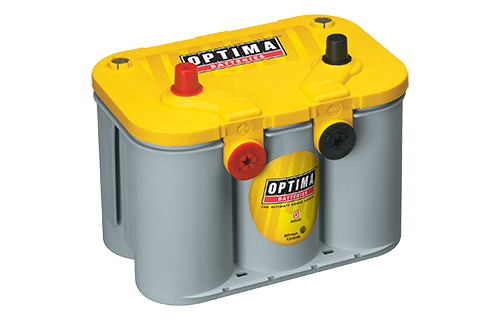
Like the RedTop 34/78, this battery has additional side posts. It's a deep cycle plus cranking battery.
A good rule of thumb for YellowTop Optimas is this:
If you've added something to your electrical system that can rapidly use electricity without immediately replenishing it, you need an Optima.
In other words, if you're going to do something that drains your battery down, use a YellowTop.
Here's why:
YellowTops are deep cycle batteries. Instead of providing a small amount of its capacity in a short amount of time, deep cycle batteries can provide large amounts of their capacity - they are deep-dischargers.
If you deeply discharge a RedTop, you can damage it. If you deeply discharge a YellowTop, it says, "Is that all you got?"
Now:
If we take our Jeep above, we can imagine quite a few scenarios where being able to use a large amount of the battery's capacity would be useful.
Can I Use a YellowTop for Starting?
Yes!
The deep cycling ability of the YellowTop is like an added feature - that's why they cost more.
In comparison to a RedTop, they should theoretically be less performant at starting, but for almost anyone this is going to be unnoticeable.
Winching
Winching is one of the best use cases for a YellowTop. There is no way any stock alternator (and probably almost any high output alternator) can keep up with the electrical drain of a winch.
A winch pull in fender deep mud can easily result in a nearly 500 amp load on the electrical system. Do that for 30 second spurts until you get out.
How full do you think your battery will be?
Not very.
The battery will be deeply discharged and need to be filled up again with electricity. Using a RedTop like this will eventually destroy it.
But that's what a YellowTop is built for.
12 Volt Refrigerators/Coolers
This is another prime example.
12V fridges need to run all the the time to keep your food cool. That means not only while you're driving, but also while you're sleeping, hiking, eating, sitting around a campfire, or whatever else you do.
A good 12 volt fridge coupled with a YellowTop can keep your food cool for a few days without being charged. When you do charge it, the YellowTop can deal with it.
Again, this is not a job for a RedTop.
Sound and Video Systems
If you have a monster sound or video system, you need to think a little differently than with our above examples.
If you'll only use your system while cruising and it isn't too big, you can use a RedTop.
If you plan to park at meets and parties and show off or your system is 250 watts or more over stock, you need a YellowTop.
Other Uses
You should choose an Optima YellowTop for any situation that will result in a deep discharge of the battery. This includes things like:
- Vehicles that don't even have a charging system: This is common for drag racers and others that don't want or need the complexity and weight of a charging system.
- Electric vehicles: It probably goes without saying that something that runs on electricity will deeply drain batteries.
- Equipment that uses a lot of electricity to run pumps, actuators, hydraulics, lights, etc., especially when that equipment is used without a running engine.
- Trolling motors: You go out all day and recharge your YellowTop at night.
- Portable welding setups: If you use a Ready Welder or you ever weld with batteries, YellowTops are the way to go.
When to Use a BlueTop Optima
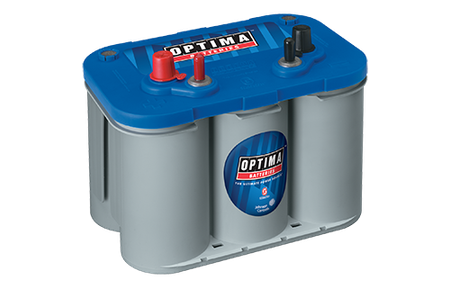

Similar size to the D34M.
Similar size to the D34M.
BlueTop Optimas are for marine use where you need a starting battery OR a deep cycle.
You see, Optima kind of made this a little confusing for us. Where RedTops and YellowTops are differentiated by being either starting or deep cycle batteries, the BlueTop line has both.
So, BlueTop Optimas have two case colors:
- Dark Gray: This is the "starting" BlueTop. It is functionally equivalent to a RedTop Optima.
- Light Gray: This is the "deep cycle" BlueTop. It is functionally equivalent to a YellowTop Optima.
"But", you ask, "how is the BlueTop actually different from a Red or YellowTop?"
BlueTops have stainless steel terminal studs in addition to the auto battery terminals.
Because of the extra staineless studs, these batteries are good for adding more accessories on a boat or for hooking up to a trolling motor.
If you need to choose between a dark case and a light case BlueTop Optima, it's just like choosing between a Red or YellowTop:
- Dark case BlueTops are for use as a dedicated started battery that isn't drained on a regular basis.
- Light case BlueTops are for RVs, trolling motors, and boats that have a lot of electrical accessories.
If you're a landlubber, don't worry too much about BlueTops unless you find a good deal on one.
A Final Note on Choosing the Best Optima Color
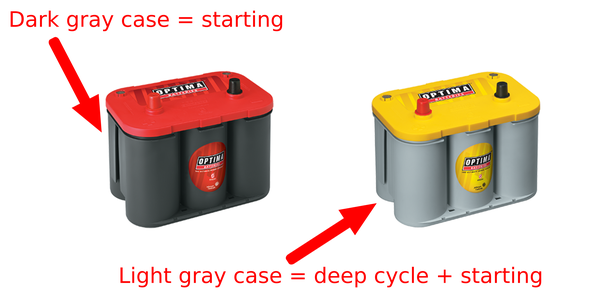
ALL dark gray case Optimas are for starting. ALL light gray case Optimas are for deep cycling and starting.
If you're easily confused and you already know what you want, you can skip this section. If you want a little more trivia, this is the section for you!
We just wanted to emphasize that you can split Optima batteries by cap color (red, yellow, blue) or by case color (dark gray and light gray). Most people know about the different cap colors, but they don't know about the different case colors.
There are two case colors:
- Dark gray case colors are starting batteries.
- Light gray case colors are deep cycle batteries.
All RedTops have dark gray cases. (They are starting batteries.)
All YellowTops have light gray cases. (They are deep cycle batteries.)
BlueTops have dark gray and light gray cases. (Some are starting and some are deep cycle batteries.)
The thing is, you probably can't walk into an auto parts store and ask for a light gray case Optima - nobody will know what that is. But they will know what a YellowTop Optima is!
Choose the Best Optima Post Configuration
Let's talk a little about fitment. Once you choose the best color, you need to pick a post layout.
First, there are top, side, and dual terminal layouts. See some common battery post layouts here:
| Manufacturer | Terminal configuration | Battery Group |
|---|---|---|
| GM and Chrysler | Dual Terminal | 34/78 |
| Toyota, Nissan, Honda, Subaru | Top Terminal | 35 |
| Toyota, Honda, Lexus, Infiniti, Nissan, Acura | Top Terminal | 24/24F |
| GM and Chrysler | Side Terminal | 75 |
| Mercury and Ford | Top Terminal | 65 |
For our purposes, we like to use the top terminal Group 34 or the dual terminal Group 34/78 if possible.
Why?
For large electrical loads like a winch, you always want to be pulling power through the large top terminals.
For small accessory loads, side terminals are fine for running things like rock lights, GPSes, or other low draw accessories.
If Optima doesn't actually recommend a specific battery for you, here's what you need to know about terminal layouts:
12 volt auto batteries have standard terminal layouts. The battery terminals are offset to one side. If you're looking at the terminal side of the battery, the positive post can be on either the left or the right.

These terminal configurations account for most car/4x4 batteries. If you think you need stainless steel terminals, look at the BlueTops.
You'll want to match this terminal orientation to whatever you have in your rig. If you don't, your battery cables will likely be too short.
Of course, for custom setups you can stick the terminals where ever you want.
If you can, we'd recommend going with a RedTop 34/78 or a YellowTop D34/78 as they tend to be the most "supported" by companies that make Optima battery trays.
Choose the Best Optima Size
For most standard 4x4s, we recommend the 34, 34/78, D34, or D34/78.
Why?
As we said above, aftermarket battery trays from performance companies tend to produce battery trays that'll fit these batteries.
If you go with a different Optima model and want to use it with an aftermarket battery tray, be careful:
Some Optimas, like the 34R have feet that will prevent you from using some trays. The tricky part is that the outer case is the same size as a normal 34 - it's just the feet that stick out !
We've heard of some people carefully cutting off the feet to get the battery to fit a particular tray.
Unless you have a particular reason not to, we suggest you stick with one of the "standard" Optimas:
- 34
- 34/78
- D34
- D34/78
Optima Battery Trays
Many aftermarket batteries trays are specifically made to fit Optima batteries. If you need a super clean tray for a single Optima battery, check out the ICT Billet Aluminum Battery Tray. It's:
- Low profile
- Lightweight
- As close to invisible as you can get
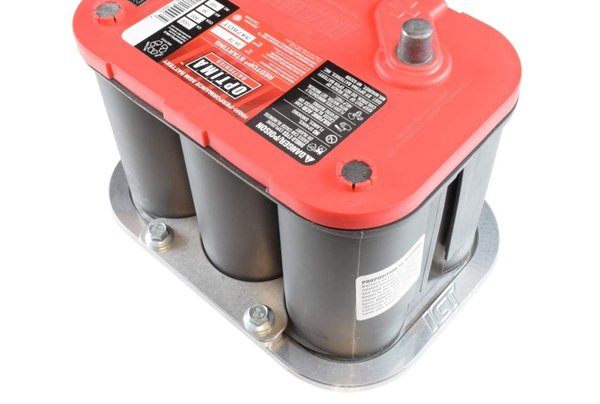
This aluminum tray fits Optimas with the standard 6-pack configuration. It won't fit batteries with staggered cells.
It clamps to the "foot" of the Optima, so it doesn't stick up. Of course, once you have this tray, you're committed to Optimas until you swap the tray out.
For dual battery setups, we recommend either a side-by-side or inline mount from a company like RuffStuff Specialties or Trail Gear.
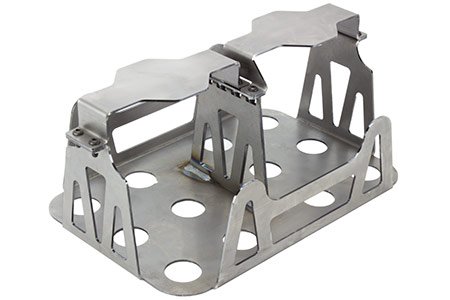
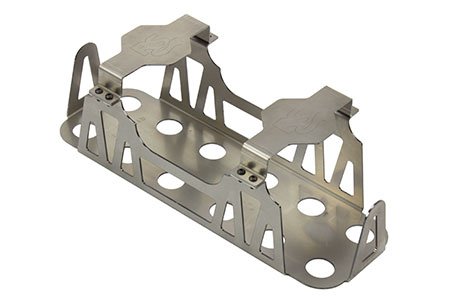
This is our only side by side battery tray. It's great if you have room to do this in your engine compartment, but this arrangement is too tight for most of us.
There's a good chance this is the only end-to-end dual battery tray out there! Weld or bolt it on.
You should pay attention to the differences between these trays:
Battery trays like the RuffStuff have battery clamp "wings" that make them impossible to flush mount. If you need that capability, look at the Trail-Gear battery trays:
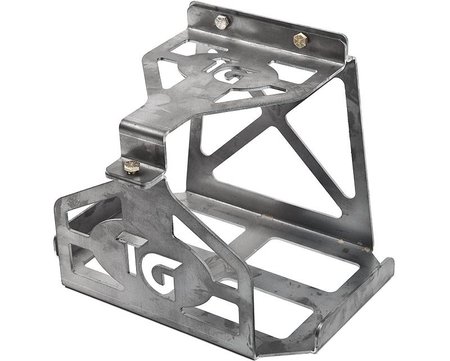
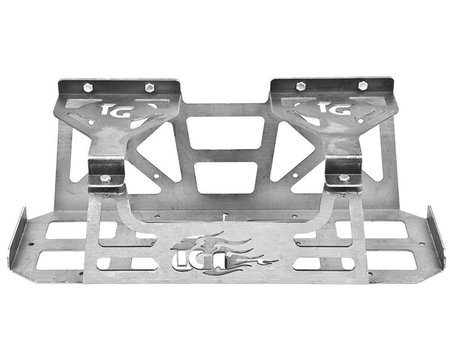
It's probably worth noting that if you need a little extra height, you can shim the single vertical hold-down bolt, and slot the two horizontal hold-down holes.
This tray allows you to mount batteries end-to-end, and will also sit flush against a vertical surface.
Source: https://www.roundforge.com/articles/which-optima-battery-best/
0 Response to "Gel Battery Slag12100dt Optima Blue Top Battery Opt8016103"
Enregistrer un commentaire